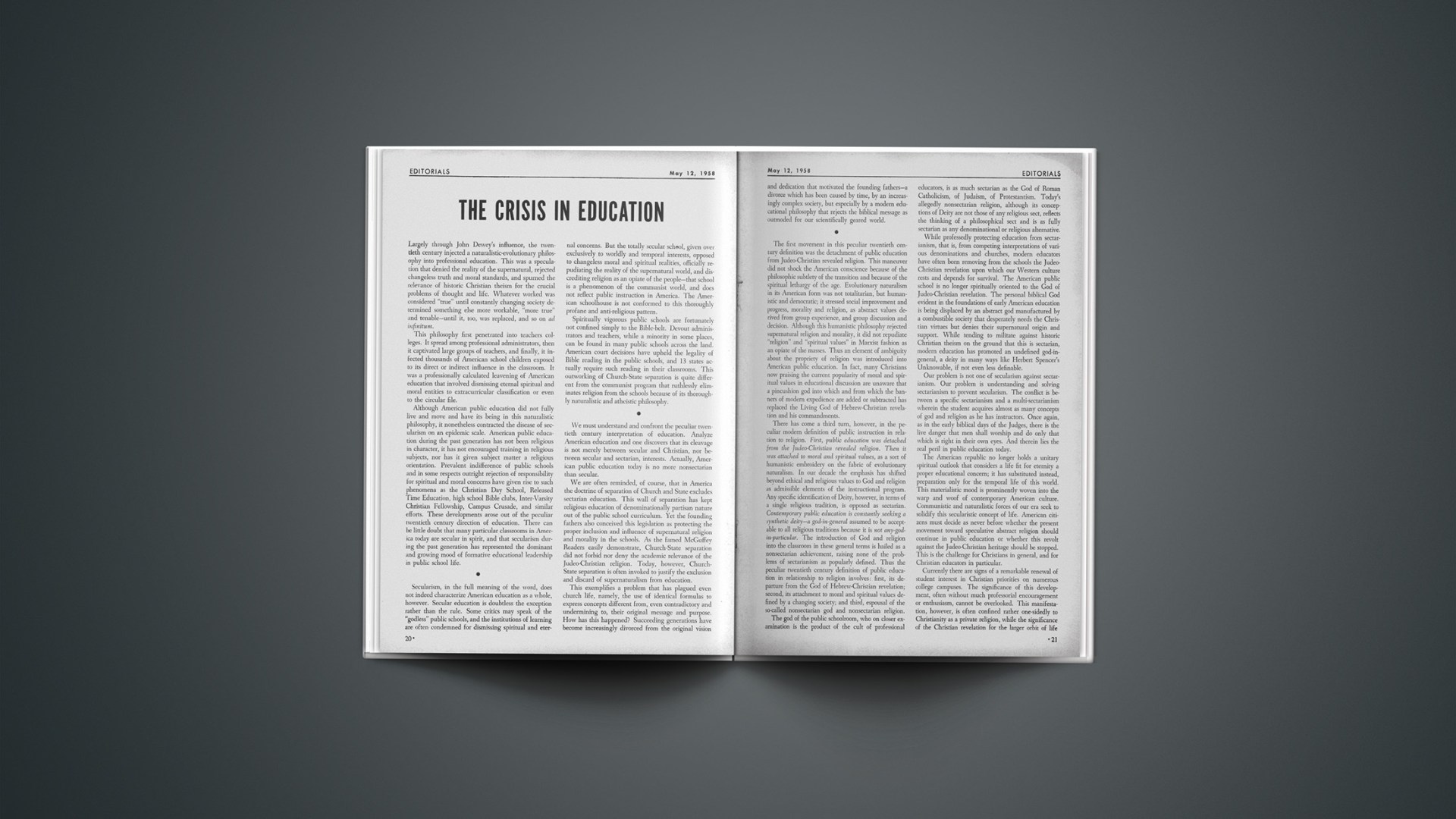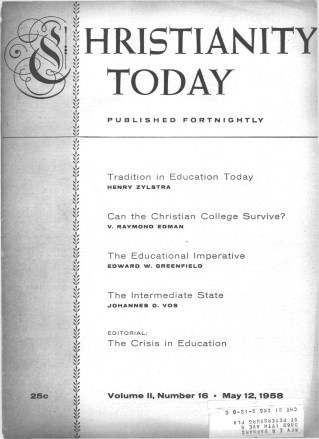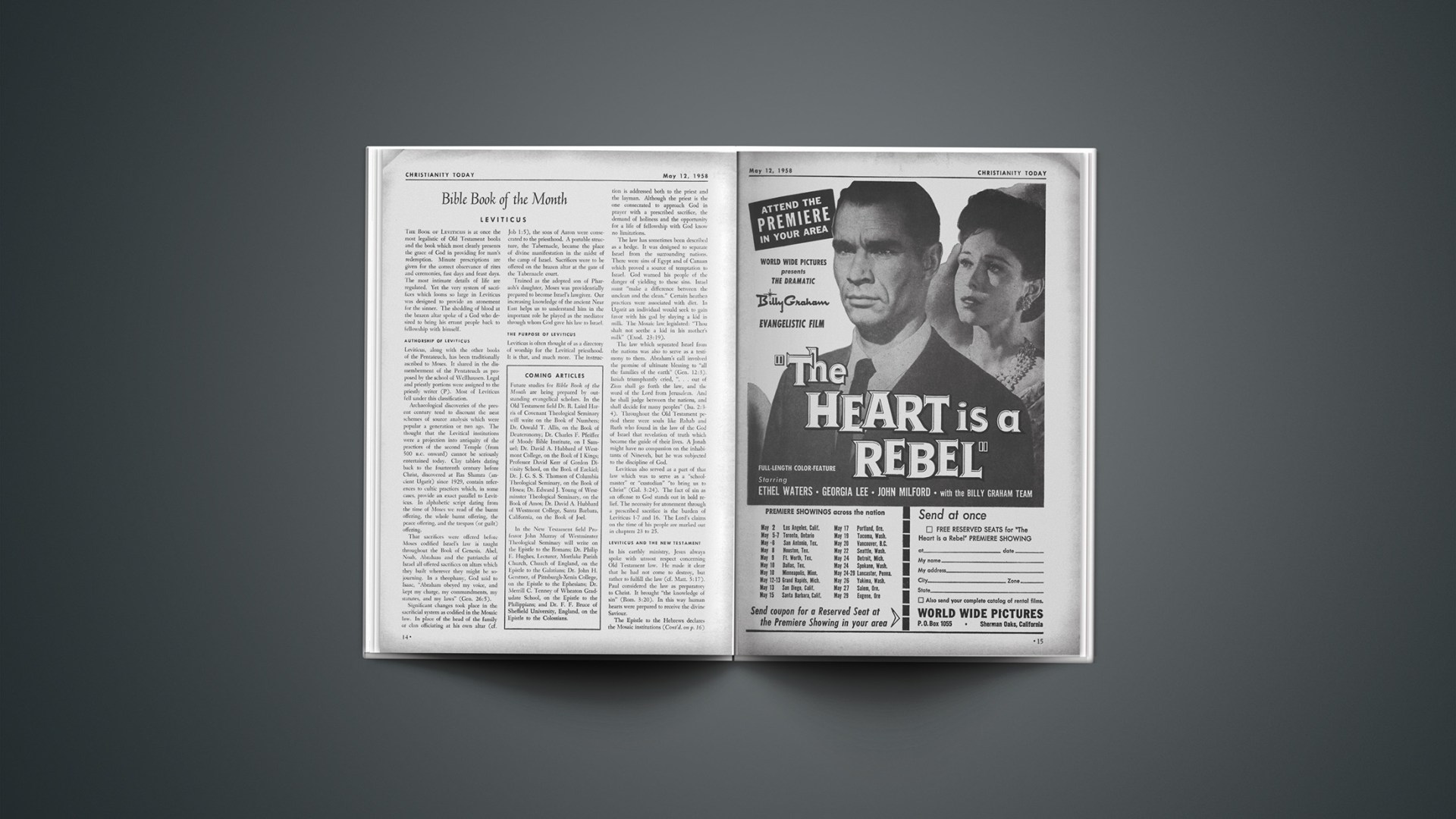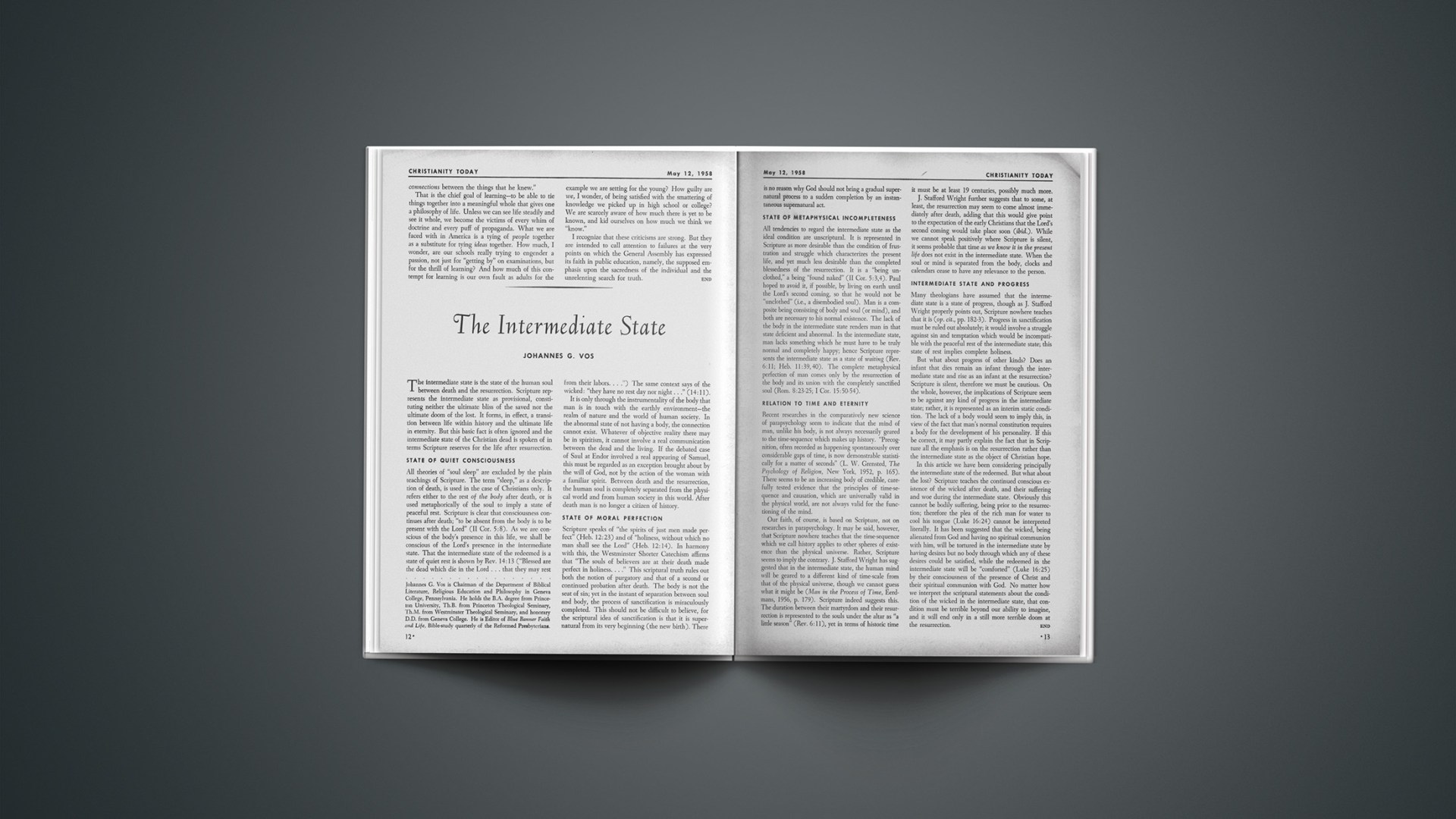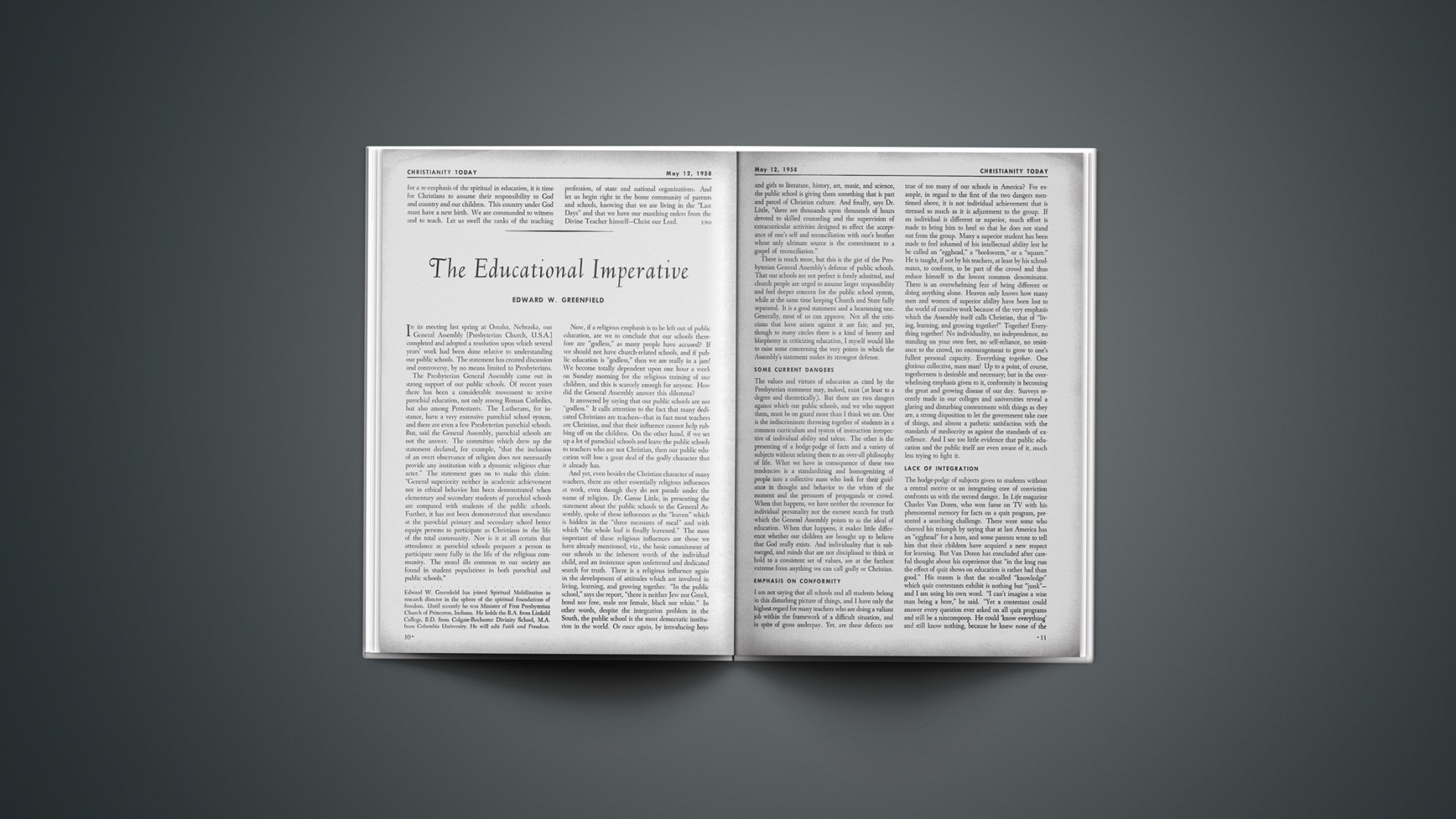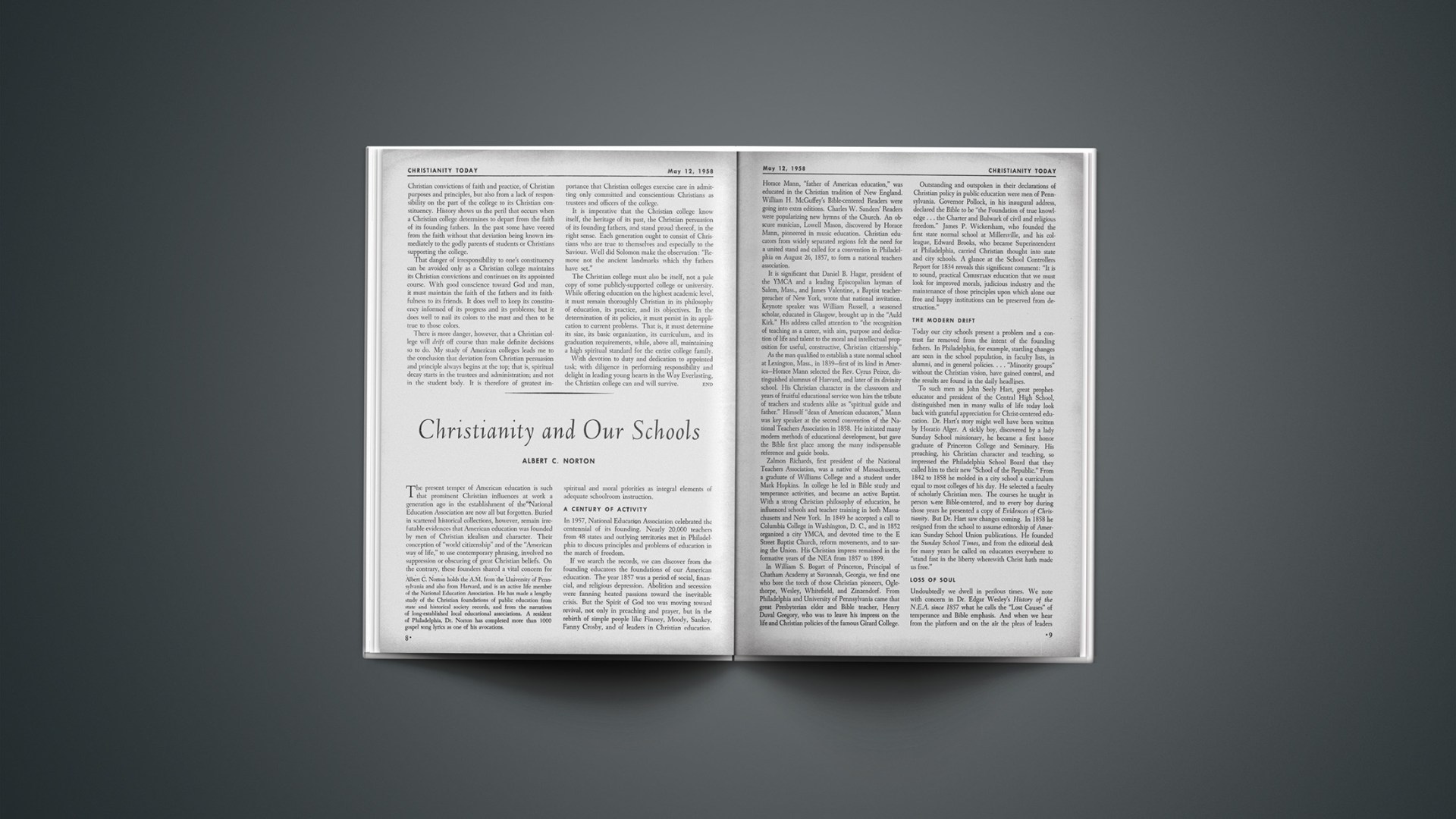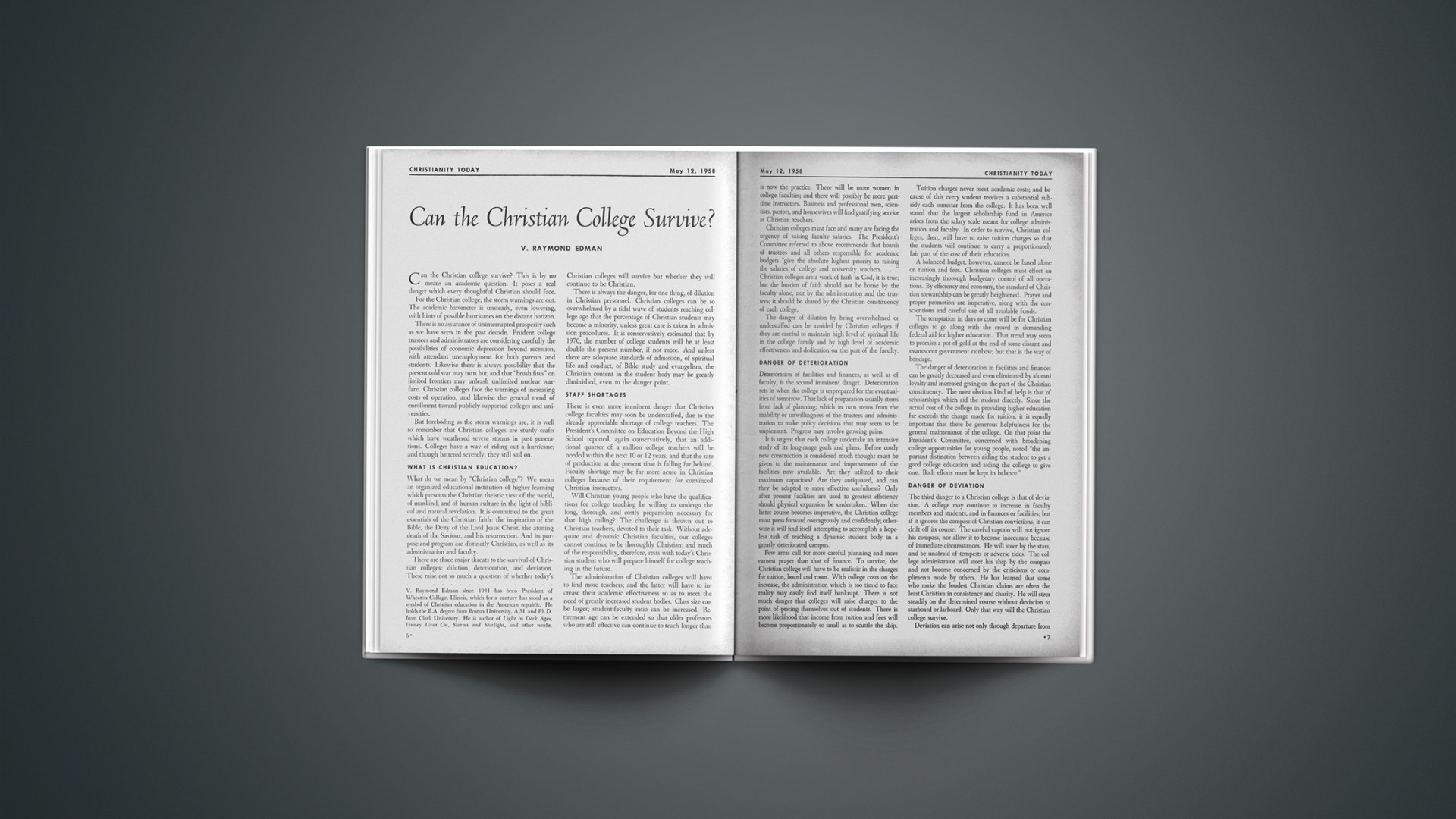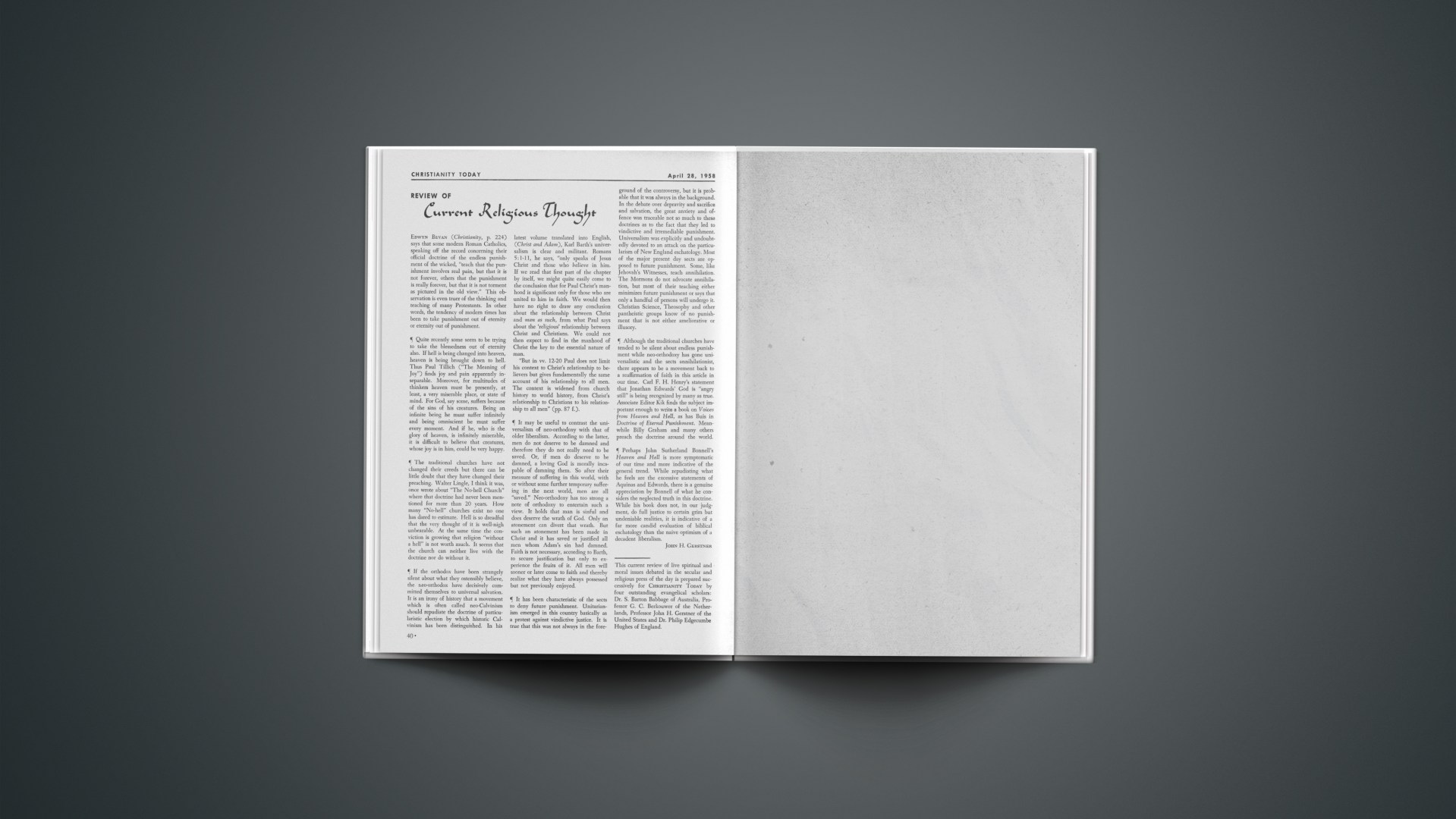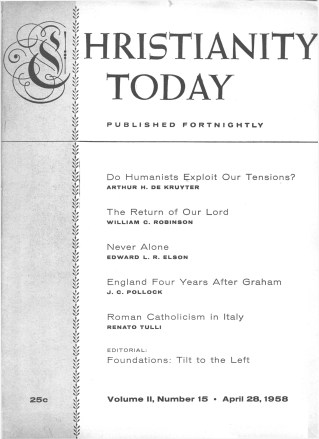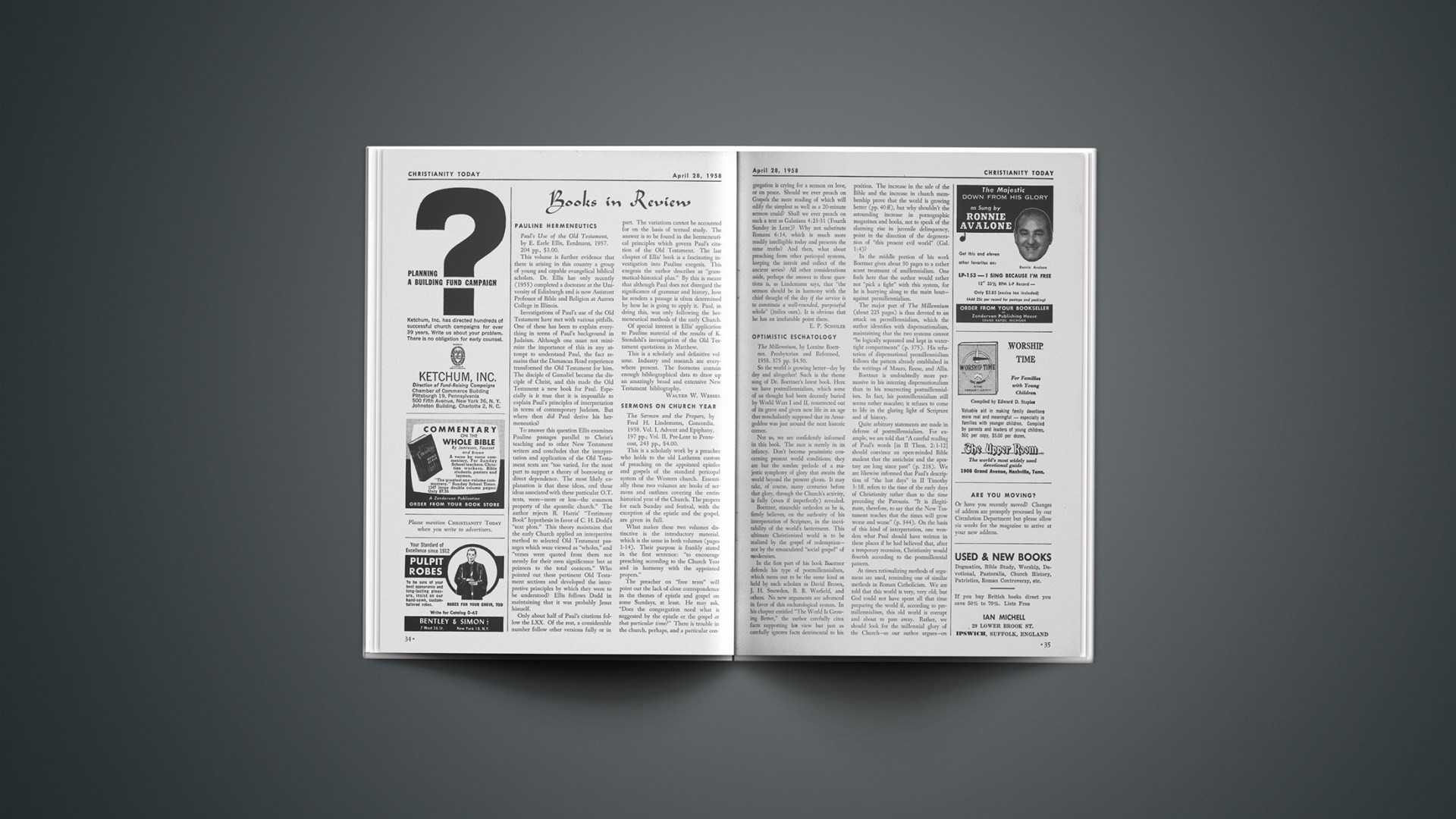Largely through John Dewey’s influence, the twentieth century injected a naturalistic-evolutionary philosophy into professional education. This was a speculation that denied the reality of the supernatural, rejected changeless truth and moral standards, and spurned the relevance of historic Christian theism for the crucial problems of thought and life. Whatever worked was considered “true” until constantly changing society determined something else more workable, “more true” and tenable—until it, too, was replaced, and so on ad infinitum.
This philosophy first penetrated into teachers colleges. It spread among professional administrators, then it captivated large groups of teachers, and finally, it infected thousands of American school children exposed to its direct or indirect influence in the classroom. It was a professionally calculated leavening of American education that involved dismissing eternal spiritual and moral entities to extracurricular classification or even to the circular file.
Although American public education did not fully live and move and have its being in this naturalistic philosophy, it nonetheless contracted the disease of secularism on an epidemic scale. American public education during the past generation has not been religious in character, it has not encouraged training in religious subjects, nor has it given subject matter a religious orientation. Prevalent indifference of public schools and in some respects outright rejection of responsibility for spiritual and moral concerns have given rise to such phenomena as the Christian Day School, Released Time Education, high school Bible clubs, Inter-Varsity Christian Fellowship, Campus Crusade, and similar efforts. These developments arose out of the peculiar twentieth century direction of education. There can be little doubt that many particular classrooms in America today are secular in spirit, and that secularism during the past generation has represented the dominant and growing mood of formative educational leadership in public school life.
Secularism, in the full meaning of the word, does not indeed characterize American education as a whole, however. Secular education is doubtless the exception rather than the rule. Some critics may speak of the “godless” public schools, and the institutions of learning are often condemned for dismissing spiritual and eternal concerns. But the totally secular school, given over exclusively to worldly and temporal interests, opposed to changeless moral and spiritual realities, officially repudiating the reality of the supernatural world, and discrediting religion as an opiate of the people—that school is a phenomenon of the communist world, and does not reflect public instruction in America. The American schoolhouse is not conformed to this thoroughly profane and anti-religious pattern.
Spiritually vigorous public schools are fortunately not confined simply to the Bible-belt. Devout administrators and teachers, while a minority in some places, can be found in many public schools across the land. American court decisions have upheld the legality of Bible reading in the public schools, and 13 states actually require such reading in their classrooms. This outworking of Church-State separation is quite different from the communist program that ruthlessly eliminates religion from the schools because of its thoroughly naturalistic and atheistic philosophy.
We must understand and confront the peculiar twentieth century interpretation of education. Analyze American education and one discovers that its cleavage is not merely between secular and Christian, nor between secular and sectarian, interests. Actually, American public education today is no more nonsectarian than secular.
We are often reminded, of course, that in America the doctrine of separation of Church and State excludes sectarian education. This wall of separation has kept religious education of denominationally partisan nature out of the public school curriculum. Yet the founding fathers also conceived this legislation as protecting the proper inclusion and influence of supernatural religion and morality in the schools. As the famed McGuffey Readers easily demonstrate, Church-State separation did not forbid nor deny the academic relevance of the Judeo-Christian religion. Today, however, Church-State separation is often invoked to justify the exclusion and discard of supernaturalism from education.
This exemplifies a problem that has plagued even church life, namely, the use of identical formulas to express concepts different from, even contradictory and undermining to, their original message and purpose. How has this happened? Succeeding generations have become increasingly divorced from the original vision and dedication that motivated the founding fathers—a divorce which has been caused by time, by an increasingly complex society, but especially by a modern educational philosophy that rejects the biblical message as outmoded for our scientifically geared world.
The first movement in this peculiar twentieth century definition was the detachment of public education from Judeo-Christian revealed religion. This maneuver did not shock the American conscience because of the philosophic subtlety of the transition and because of the spiritual lethargy of the age. Evolutionary naturalism in its American form was not totalitarian, but humanistic and democratic; it stressed social improvement and progress, morality and religion, as abstract values derived from group experience, and group discussion and decision. Although this humanistic philosophy rejected supernatural religion and morality, it did not repudiate “religion” and “spiritual values” in Marxist fashion as an opiate of the masses. Thus an element of ambiguity about the propriety of religion was introduced into American public education. In fact, many Christians now praising the current popularity of moral and spiritual values in educational discussion are unaware that a pincushion god into which and from which the banners of modern expedience are added or subtracted has replaced the Living God of Hebrew-Christian revelation and his commandments.
There has come a third turn, however, in the peculiar modern definition of public instruction in relation to religion. First, public education was detached from the Judeo-Christian revealed religion. Then it was attached to moral and spiritual values, as a sort of humanistic embroidery on the fabric of evolutionary naturalism. In our decade the emphasis has shifted beyond ethical and religious values to God and religion as admissible elements of the instructional program. Any specific identification of Deity, however, in terms of a single religious tradition, is opposed as sectarian. Contemporary public education is constantly seeking a synthetic deity—a god-in-general assumed to be acceptable to all religious traditions because it is not any-god-in-particular. The introduction of God and religion into the classroom in these general terms is hailed as a nonsectarian achievement, raising none of the problems of sectarianism as popularly defined. Thus the peculiar twentieth century definition of public education in relationship to religion involves: first, its departure from the God of Hebrew-Christian revelation; second, its attachment to moral and spiritual values defined by a changing society; and third, espousal of the so-called nonsectarian god and nonsectarian religion.
The god of the public schoolroom, who on closer examination is the product of the cult of professional educators, is as much sectarian as the God of Roman Catholicism, of Judaism, of Protestantism. Today’s allegedly nonsectarian religion, although its conceptions of Deity are not those of any religious sect, reflects the thinking of a philosophical sect and is as fully sectarian as any denominational or religious alternative.
While professedly protecting education from sectarianism, that is, from competing interpretations of various denominations and churches, modern educators have often been removing from the schools the Judeo-Christian revelation upon which our Western culture rests and depends for survival. The American public school is no longer spiritually oriented to the God of Judeo-Christian revelation. The personal biblical God evident in the foundations of early American education is being displaced by an abstract god manufactured by a combustible society that desperately needs the Christian virtues but denies their supernatural origin and support. While tending to militate against historic Christian theism on the ground that this is sectarian, modern education has promoted an undefined god-in-general, a deity in many ways like Herbert Spencer’s Unknowable, if not even less definable.
Our problem is not one of secularism against sectarianism. Our problem is understanding and solving sectarianism to prevent secularism. The conflict is between a specific sectarianism and a multi-sectarianism wherein the student acquires almost as many concepts of god and religion as he has instructors. Once again, as in the early biblical days of the Judges, there is the live danger that men shall worship and do only that which is right in their own eyes. And therein lies the real peril in public education today.
The American republic no longer holds a unitary spiritual outlook that considers a life fit for eternity a proper educational concern; it has substituted instead, preparation only for the temporal life of this world. This materialistic mood is prominently woven into the warp and woof of contemporary American culture. Communistic and naturalistic forces of our era seek to solidify this secularistic concept of life. American citizens must decide as never before whether the present movement toward speculative abstract religion should continue in public education or whether this revolt against the Judeo-Christian heritage should be stopped. This is the challenge for Christians in general, and for Christian educators in particular.
Currently there are signs of a remarkable renewal of student interest in Christian priorities on numerous college campuses. The significance of this development, often without much professorial encouragement or enthusiasm, cannot be overlooked. This manifestation, however, is often confined rather one-sidedly to Christianity as a private religion, while the significance of the Christian revelation for the larger orbit of life and thought is neglected. Kenneth Underwood has remarked in an article on “The University, The Church, and Involvement in Public Life” (The Chicago Theological Seminary Register, Feb., 1958) that “the secular university, while undoubtedly more tolerant than a decade ago toward personal religion, and perhaps toward theology as a discipline, would yet hesitate to do more than add a post or so to the religion department or perhaps rebuild the chapel.” The Christian vision of the world of thought and life belongs to the past; the present is dominated still by rival visions.
The Constitution specifies that “Congress shall make no law respecting an establishment of religion, or prohibiting the free exercise thereof.” The legislative prohibition of alliance between Church and State excludes as well any alliance between public education and the private philosophy of professional educators so replete with gods. Thomas Jefferson, who emphasized the “wall of separation between Church and State,” would not have hesitated today to apply to humanistic or idealistic teaching his declaration that “to compel a man to furnish contributions of money [as every public school taxpayer does] for the propagation of opinions which he disbelieves is sinful and tyrannical.” By the above Constitutional decree, the Christian teacher is entitled to no more right to press for a particular religious identification in the course of professional duties than the secular teacher or any other teacher who speaks of spiritual values only, or of deity in some abstract and speculative sense. To grant the Christian teacher less rights, however, is to discriminate against Christian conviction in favor of the multi-sectarianism of modern education. The Christian parent and the Christian teacher are surely entitled to as much voice as the parent and teacher devoted to modern sectarian gods.
Amid the experimental mood of polytheistic modern education, the Christian teacher must proceed to Mars Hill. In the words of the Declaration of Independence, and not of biblical theology alone, he must speak plainly of the Creator who has endowed men with inalienable rights, that these rights may continue to distinguish and refine Western culture to the glory of God.
Pressures Rise For Federal Handouts
The grab for Federal funds is on the rise, but American taxpayers remain complacent about the situation.
The Indiana Catholic and Record (March 7 issue) reports on relief given to the world’s needy through Catholic Relief Services. The Archbishop of the Archdiocese of Indianapolis, approaching clergy and laity for the annual Bishops’ Relief Fund Appeal, wrote: “Last year … Catholics throughout the United States put into our hands something over $5,000,000. By a careful use of this money and through the cooperation of our American government, our committee carried on a program of relief and resettlement during 1957 that was worth $148,000,000!” (italics supplied).
Bishop Fulton J. Sheen brazenly proposed to the White House conference in March that foreign aid be channeled through private religious and educational institutions to divest it of materialistic overtones. The ecclesiastical prestige Rome has already achieved through supervision of relief distributions doubtless encouraged Bishop Sheen’s shocking proposal. Church and State, monthly review of Protestants and Other Americans United, notes that “such a bold bid for power by a religious denomination is almost without parallel in our annals.” It adds that “ecclesiastical control of foreign aid would turn this program into a power tool of the Roman hierarchy.”
Foreign aid tensions are mounting for additional reasons. The American mentality is more and more being propagandized (at taxpayers’ expense) to support large Federal commitments. Republican government has indeed come upon sad times when political leaders, distrustful of democratic processes, achieve their predetermined objectives through mass propaganda pressures upon the citizenry. At the Washington conference on “Foreign Aspects of U. S. National Security,” distinguished officeholders of both parties shared in a well-timed promotional spectacle that imported Hollywood stars and glamour personalities to promote foreign aid. The procedure implied the cheapest cynicism over democratic processes.
Protestant spokesmen professed to find in the Gospel itself a legitimation of the present foreign aid program. President Dahlberg of the NCC disclaimed representing all his constituency (“As president of the National Council … with a total membership of 38,000,000 people, I cannot pretend to voice the unanimous viewpoints of so huge a section of the Christian Church”), yet he cast the Council’s weight aggressively behind the foreign aid program (“… on the basis of the expressed resolutions adopted by the 2,000 delegates present at our Triennial Assembly in St. Louis early in December and judging by close to a thousand letters coming to me … I know that I am bringing to you the deepest convictions of a very large and important cross section of American Christianity. In behalf of the National Council …”). President Eisenhower even hailed foreign aid as a modern application of the Golden Rule. But is Christian conscience fully bound to support foreign aid in its present scope and spirit? Does the Golden Rule require support of Tito and Franco, and mere sympathy for victims of Hungarian tyranny? Indeed, does the Church really possess “another gospel” to preserve a world that spurns Christ’s lordship? The issue is not the tenability of some forms of government aid, but its status as a divine imperative of the Church.

